In this deep dive, we will cover creating your plan for the technical execution of all your growth priorities.
In the previous article, we covered the overall SaaS growth journey and introduced concepts that helped you pick your likely go-to-market strategy based on your differentiators, positioning, and target market segment. Then we covered how you lead a strategy workshop with your team to answer the questions: 1) Who's it for? and 2) What's it for?
In that workshop, there’s a vital third component called the Growth Matrix based on something called the Ansoff Matrix. We have taken the Ansoff and tuned it a little bit to assist with this specific exercise. It's a tool based on two dimensions that help you collect, organize, and prioritize your growth initiatives. It’s really helpful to do a workshop to then inform your marketing, sales, and product teams with priorities to really execute the right go-to-market plan.
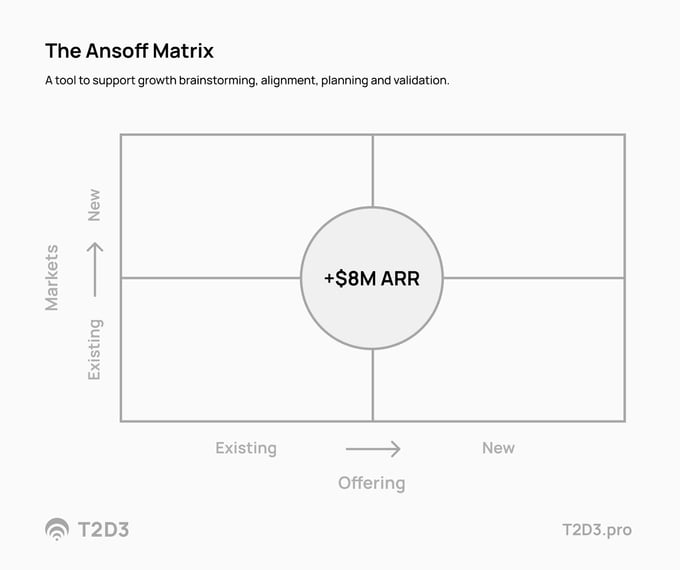
Using a growth matrix to brainstorm
A growth matrix is a brainstorming tool for alignment, planning, and validating whether certain growth tactics are the right one for you. It's really meant to help answer the question, “where will your growth come from?”. So you can almost say, Hey, let's put the number in the middle. That is your growth assumption. That number was likely a part of your investment thesis when you got growth capital, or maybe it's part of your long-term strategy for the company. For example, you plan to grow in the year with eight million in annual recurring revenue. This exercise helps you reverse engineer where this growth is actually expected to come from. You made certain assumptions when you came up with this number. It basically answers the question of what has to happen, or what has to be true, for you to realize this growth.
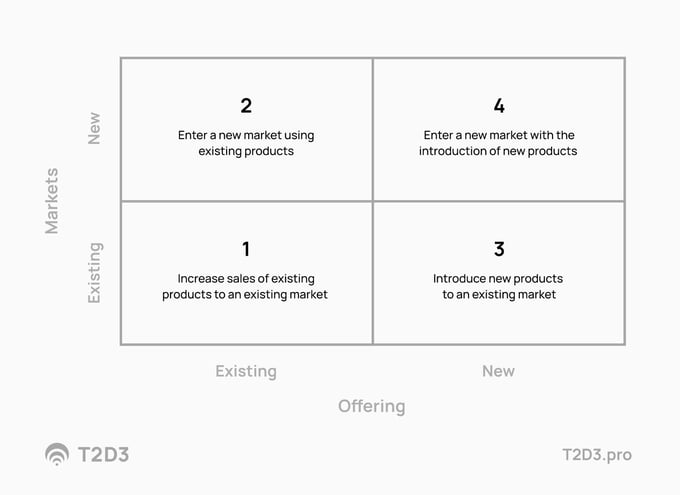
To do this exercise, we use four quadrants made up of two axes. The vertical axis differentiates between the markets that you are already servicing, the markets that you are already in, your current customers, and customers that look like those. On the upper side of that vertical axis, you have markets that you could enter, given the right focus and resources, but you're not servicing those markets today. On the horizontal axis, you find the dimension of what type of offerings you have today or existing offerings, your current products, your services, and your capabilities. Then, if you go more to the right, those would be products and offerings that you could develop to drive future growth.
The model helps organize and prioritize opportunities to drive growth along these two axes. On the lower left, you have your current customers and prospect, your current market segments that you address with your current products. This is usually the lowest risk area for you to grow and the most obvious place to start with your growth planning.
Then on the left, there is a quarter to enter new markets with current products. So an example would be to go upmarket from small businesses to focus on larger enterprise clients. You can focus on market development and reaching a new type of customer. This is usually a medium risk growth opportunity where the lower left quadrant is a lower risk, growth opportunity is easier.
Then the third quadrant on the lower right, there you focus on expansion through product development and bringing new products and capabilities to your current customers and your current market segments. This is also considered medium risk.
Finally, the upper right quadrant is really to drive growth from new markets, with new products. It's the highest risk opportunity of these four quadrants. It's the most dramatic move businesses can make according to this model. Really that’s venturing into new territory. It's often safer to go to that upper right quadrant by traveling through the lower right or the upper left quadrant and get there one step at a time instead of two steps at a time.
Risk and reward
Sometimes, you need to pivot. You need to go into a completely different direction. If there's urgency there, then the upper right quadrant might be viable for you. As you fill out these quadrants, you will learn where you have leverage, what growth levers you have at your disposal. For example, between product-led growth, marketing-led growth, sales-led growth, all these different go-to market models, doing this work in this exercise will really help you cement if one or a combination of those three is the right go-to-market plan for you given your growth ambitions.
The matrix will help you prioritize and sequence execution and marketing and growth tactics, align your leadership team on those priorities, and then plan and budget resources accordingly, while understanding what the growth dependencies are. You'll learn when to pivot, or more importantly, when not to go into that upper right quadrant because you still have plenty of work to do on the lower left and the other two quadrants.
Discover all the things you could do before you need to pivot. Where do you find your lowest-hanging fruits? How do you validate and value specific initiatives? This exercise can really inform your product roadmap. It can help you with reporting to investors, and pitching investors on new growth. It will also allow you to have a more diversified and focused growth plan at the same time.
Different approaches to growth
The chart below shows a couple of names that you sometimes see being used for these quadrants. And again, while you can pursue growth from multiple quadrants simultaneously. It is helpful to prioritize where to start.
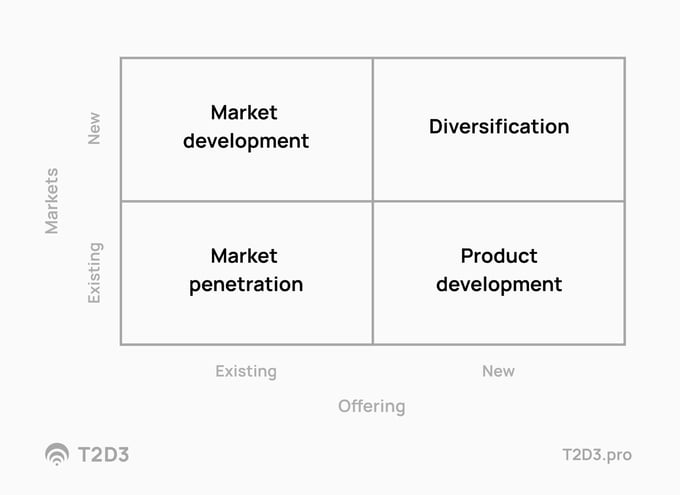
Market penetration is all about driving more market share from your current ideal customer profile or ICP (the lower left quadrant). You optimize and you exploit a potential dominated market presence that you already have in certain segments of the market. Market development (upper left) is about creating new beachheads. Finding new places in the market where you can build a strong position, the product-market fit with your current offering. So you expand, if you think of TAM SAM SOM, into a total addressable market, serviceable addressable market and the serviceable and obtainable part of that addressable market.
On the lower right, product development, that is you developing products or capabilities to grow what I call the “share of wallet per client” in your current ICP. This is really about driving a bigger share of their wallet in the revenue that you can earn from them. You double down on your SOM and get more revenue per customer.
Diversification, the upper right, means building a new beachhead with a new capability. You of course, have to find product-market fit for this to effectively grow your SAM (serviceable addressable market). Now with that capability, you can actually service customers that you could not serve before.
Applying the matrix to the T2D3 formula
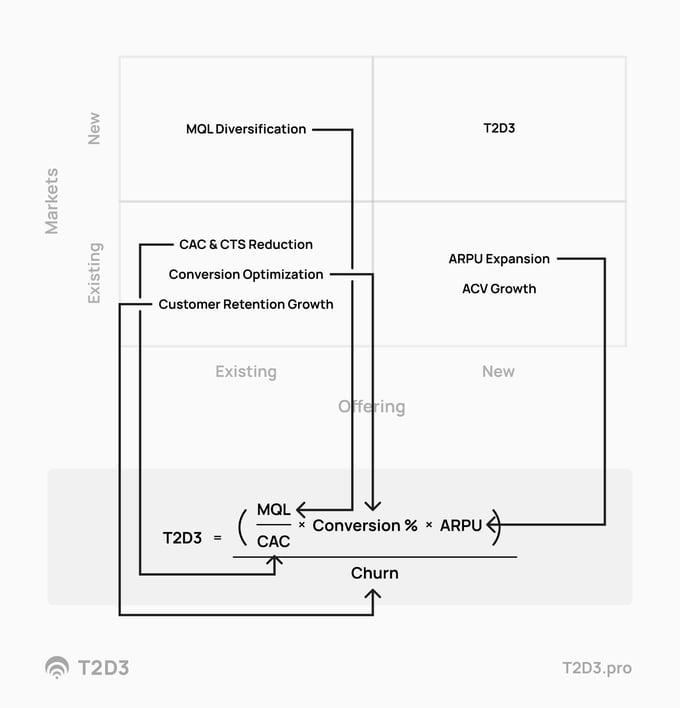
To drive T2D3 growth, the formula which is detailed above, you need to hit multiple growth quadrants in parallel. The matrix exercise will help plot which of the quadrants to expand into and the types of growth tactics to employ, and see how each of those helps you drive that ultimate combined set of growth levers to drive T2D3 growth, to drive exponential growth.
For example, when you begin with the lower left quadrant, you can get success with churn reduction. You can improve customer retention growth, customer acquisition cost, and conversion optimization. All three really impact the first part of the above line in the T2D3 equation, and then the churn number (below the line). That’s usually where I like to start, because those have phenomenal impact. It's like patching your funnel. You can pour a lot of water in, but if the water leaks out, it's not that helpful. So that's where you want to start, and you will drive more demands.
You want to patch any leaks in your funnel and then make sure the demand you generate yields optimal results before you start investing in other demand generation channels. Those might take time to get going, and can be a little more costly. ARPU expansion in the third quadrant is really the last piece. That's where you can do this in parallel. You can invest in R and D to drive more revenue from your existing customers. Just make sure that in your marketing and growth plans, you don't wait for product innovation to drive growth. Finally, in the upper left, that's really a very obvious one where of course you need to drive more MQLs and sometimes you need to enter new markets with a current offering to drive new types of MQLs from new customers.
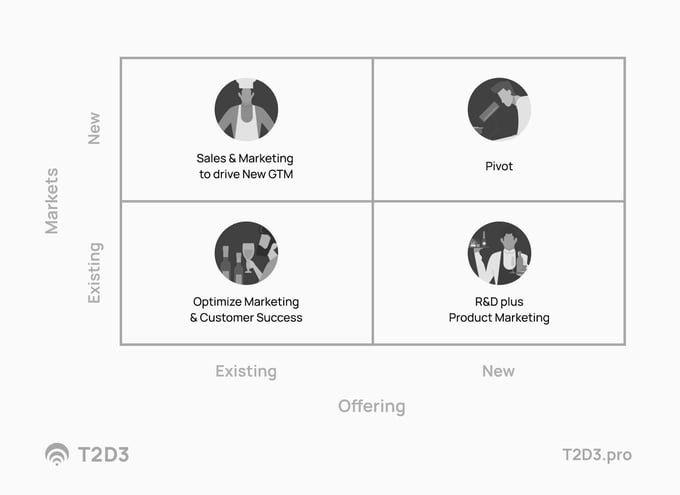
It's always helpful to have a real-world example. So let's say you run a wine business. You should always start with optimizing your customer success and marketing—basically, drive growth by selling more wine from the wine that you already have. You already have that product for the type of customers that you already service, right? Get more from your current customers by selling them more wine. You don't need to build anything new. Just have your existing customers buy more and get more sales from leads who hear about your product and drive growth from existing customers (referrals). That's all in the lower left quadrant. Your growth investment, in this case, will be mostly in your marketing and customer success or account management functions.
Then you go to the upper left where you can invest in business development and sales and marketing to expand to new markets. In this case, maybe you want to explore selling your wine to restaurants and caterers by getting their chefs and sommeliers to be your customers. You diversify the segment of prospects that you sell to, but you're still having the same product.
The lower right quadrant is building some new capability. Maybe you want to add to your portfolio, selling fruits and cheese or glasses, or other wine drinking accessories, to basically sell to the same customers. You’re selling to the customers that already buy your wine new products that you can make profitable.
Finally, the hardest move on the upper right and lowest on your priority list. It would be some kind of a pivot where you use your superpower to enter a completely new market with a new product. So, given COVID, an example would be manufacturers of alcohol who have production facilities to create alcohol products. This actually happened in some instances. They created disinfectant lotions, right? Basically, an alcoholic product in a totally new market, with a completely different product. But based on some of the things that this company already could do.
Guidelines for first-time users
From my experience, there are some rough guidelines where you should try to focus most of your resources and your energy.
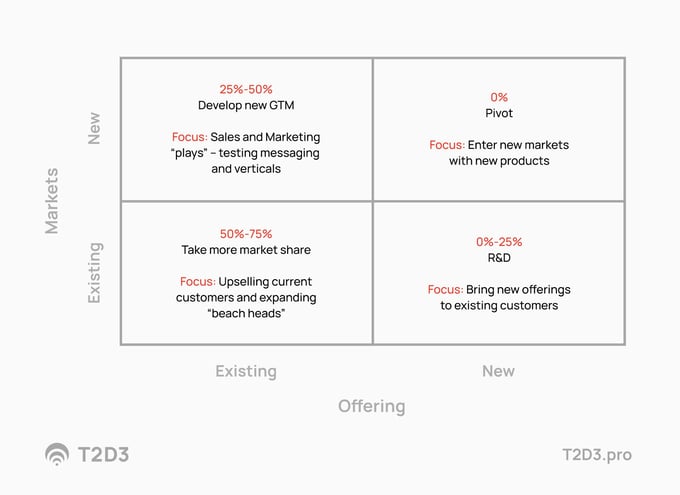
Be careful not to put too much into new markets, the upper left - but you need to do something there, right? If you focus everything on the lower left, then you might not be planning for the future. It's important to develop the next part of the market that you want to keep growing into, especially to achieve T2D3 growth.
However, the majority of your energy should be focused on the lower left, and you should only invest resources in the lower right unless you clearly hear from your customers, your existing customers, that certain capabilities would allow them to get more value from what you do.
As your market matures, it's also important that you keep investing in the lower right quadrant to keep from being caught up in the commoditization of the category that you're in. Your competitors will copy the things that make you special, right? When that happens, you need to have new innovations to make sure you can keep charging a premium and stay ahead of the competition.
I'll be a little bit passionate about saying, I think 0% in the upper right quadrant is fine. Of course, if you're in the wrong market with the wrong product, you need to invest in a pivot. In that situation, you go to that upper right quadrant. Assuming that when you're reading this, you're in a business that has an opportunity to drive growth from a market that you've discovered with a really cool product, then most of your energy should go to the other three quarters and not to the upper right.
On T2D3.pro there is a Growth Matrix Template that you can use. It's simple, easy and has examples - so you can just get started fast. I hope you will try the matrix as a tool to organize your T2D3 growth initiatives and turn them into the foundation to be executed as a technical plan across your company.
What's next?
50+ growth levers to use in your Growth Matrix
A collection of sample growth levers to help your team get started with your Growth Matrix exercise.
READ ARTICLE